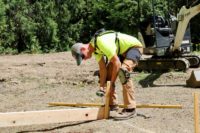OSHA conducts two general types of inspections: programmed and unprogrammed. Programmed inspections accounted for 46% of FY 2015 OSHA inspections and target specific high-hazard industries or individual workplaces that have experienced high rates of injuries and illnesses. For instance, Special Emphasis Programs (SEPs) are the primary means by which OSHA attempts to focus on the most dangerous workplaces. SEPs provide for programmed inspections of establishments in industries with high injury or illness rates and are also based on potential exposure to health hazards. Before any enforcement activities begin under any emphasis program, OSHA conducts robust and comprehensive outreach activities, educating employers about the program and providing ways to get help to abate hazards.
In addition, unprogrammed inspections accounted for 54% of OSHA inspections and are initiated for several reasons, including:
Worker complaints of hazards or violations.
Referrals of hazards from other federal, state or local agencies, individuals, organizations or the media. (For example, if OSHA is informed of a hazard, injury, or fatality through a news report, the Agency may open an investigation. Likewise, if another agency informs OSHA about a hazard, injury, or fatality that it has observed, OSHA may initiate an investigation.)
Employer reports of fatalities, inpatient hospitalizations, amputations, or loss of an eye.
Follow-up inspections to check for abatement of violations cited during previous inspections.
Preparation
Before conducting an inspection, OSHA compliance officers research the inspection history of a worksite and review the operations and processes in use and the standards most likely to apply. They also gather appropriate personal protective equipment and testing instruments to measure potential hazards.
Opening Conference
The on-site inspection begins with the presentation of the compliance officer's credentials, which include both a photograph and a serial number. The compliance officer will begin by explaining why OSHA selected the workplace for inspection and describe the scope of the inspection, how it will be conducted, employee representation, and employee interviews.
Physical Inspection
Following the opening conference, the employer selects a representative to accompany the compliance officer during the inspection. An authorized representative of the employees, if the employees select one, also has the right to go along. In all inspections, the compliance officer will select and privately interview a reasonable number of employees during the inspection. The compliance officer and the employer and employee representatives will then walk through the portions of the workplace covered by the inspection, inspecting for hazards that could lead to employee injury or illness. The compliance officer will also review worksite injury and illness records and ensure the posting of the official OSHA poster. Compliance officers attempt to minimize work interruptions during the inspection and will keep confidential any trade secrets they observe.
During the walkaround, compliance officers may point out some apparent violations that can be corrected immediately. While these hazards are still cited, prompt correction is a sign of good faith on the part of the employer, and may result in penalty reductions under OSHA's "Quick-Fix" incentive program. "Quick-Fix" is an abatement incentive program meant to encourage employers immediately to abate hazards found during an OSHA inspection, and thereby, quickly prevent potential employee injury, illness, and death. "Quick-Fix" does not apply to all violations. For example, "Quick-Fix" incentives only apply to violations classified as "other-than-serious," "low-gravity serious" or "moderate gravity serious", and not to "high gravity serious," "repeat," "willful," or "failure to abate" violations. Only corrective actions that are permanent and substantial, not temporary or cosmetic, are eligible for "Quick-Fix" penalty reductions.
Closing Conference
After the walkaround, the compliance officer holds a closing conference with the employer and the employee representatives to discuss the findings. The compliance officer discusses possible courses of action an employer may take following an inspection, which could include an informal conference with OSHA or contesting possible citations and proposed penalties. The compliance officer also discusses consultation services and employee rights.
Results
OSHA inspectors do not themselves issue citations or assess fines; they report conditions found during an inspection to their Area Director who may issue citations and propose fines. OSHA must issue any citation and proposed penalty within six months of the violation's occurrence. Citations describe OSHA requirements allegedly violated, list any proposed penalties and give a deadline for correcting the alleged hazards.
In FY 2015, OSHA issued 63,575 violations, of which 74% were cited as serious. Based on FY2015 inspection activity, more than 9,300 hazards associated with illnesses in construction and general industry were abated. Each of these means that one or more workers were removed from hazards that could have injured or possibly killed them.
Appeals
OSHA's primary goal is correcting hazards and maintaining compliance rather than issuing citations or collecting penalties. When OSHA issues a citation to an employer, it also always offers the employer an opportunity for an informal conference with the OSHA Area Director to discuss citations, penalties, abatement dates or any other information pertinent to the inspection. The agency and the employer may work out a settlement agreement to resolve the matter and to eliminate the hazard. In FY 2015, 65% of inspections with a citation resulted in informal or expedited settlements between the employer and OSHA and the average penalty reduction resulting from an informal settlement agreement was around 41.3%.
Alternatively, employers have 15 working days after receipt of citations and proposed penalties to formally contest the alleged violations and/or penalties by sending a written notice to the Area Director. In FY 2015, employers contested violations and/or penalties in 7.4% of cases. OSHA forwards the contest to the Occupational Safety and Health Review Commission (OSHRC) for independent review. Citations, penalties and abatement dates that are not challenged by the employer or settled become a final order of the OSHRC. Employers and other parties may appeal commission rulings to the appropriate U.S. Court of Appeals. Note that if a violation is contested, OSHA cannot order abatement and payment of penalties for those items contested until the OSHRC proceedings are concluded.
Whistleblower Protections
To help ensure that workers are free to participate in safety and health activities, Section 11(c) of the OSH Act prohibits any person from discharging or in any manner retaliating against any worker for exercising rights under the OSH Act. These rights include raising safety and health concerns with an employer, reporting a work-related injury or illness, filing a complaint with OSHA, seeking an OSHA inspection, participating in an OSHA inspection and participating or testifying in any proceeding related to an OSHA inspection. Protection from retaliation means that an employer cannot retaliate by taking "adverse action" against workers, for example, by firing, blacklisting, demoting, threatening, or reducing pay for a whistleblower. Employees who believe they are facing retaliation for exercising their rights must file a retaliation complaint with OSHA within 30 calendar days from the date of the alleged retaliation.
Compliance Assistance
Another major component of OSHA's strategy to protect workers is compliance assistance. OSHA maintains a substantial and diverse compliance assistance program that provides extensive assistance to employers of all sizes, but particularly to small businesses. Our commitment to compliance assistance continues to be strong, despite fewer appropriated funds for these activities since sequestration.
There are several principles under which our compliance assistance program operates:
We believe that no employer, large or small, should fail to provide a safe workplace simply because it can't get accurate and timely information about how to address workplace safety or health problems or how to implement OSHA standards.
All workers, no matter what language they speak or who their employer is, should be knowledgeable about the hazards they face, the protections they need and their rights under the OSH Act.
Employers that achieve excellence in their health and safety programs should receive recognition.


